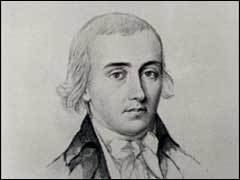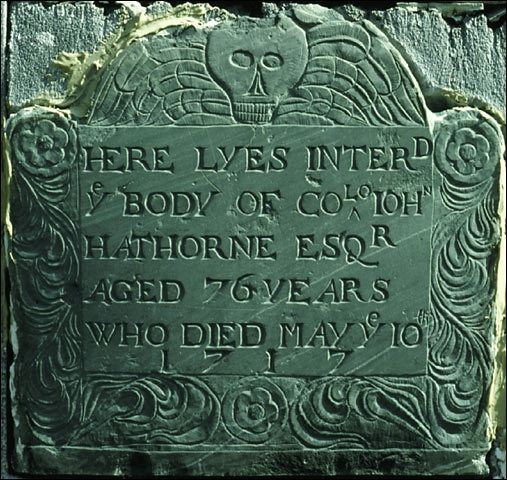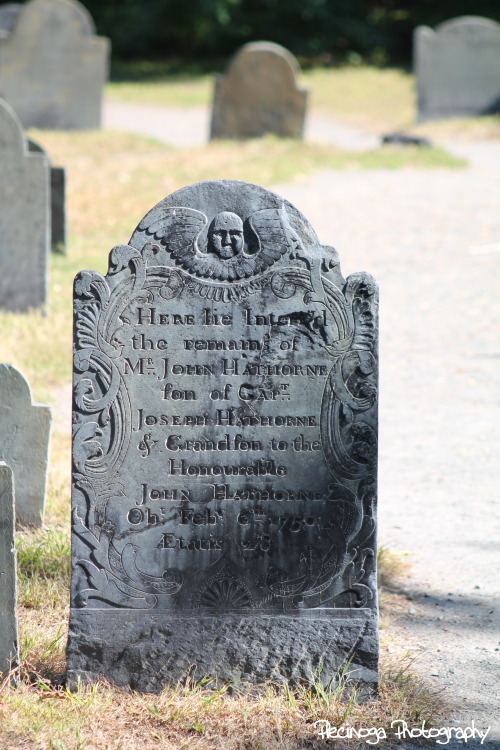Name John Hathorne | Parents William Hathorne | |
 | ||
Similar People Rebecca Nurse, John Proctor, John Hale, Cotton Mather | ||
The hanging judge john hathorne s grave salem ma
John Hathorne (August 1641 – May 10, 1717) was a merchant and magistrate of the Massachusetts Bay Colony and Salem, Massachusetts. He is best known for his early and vocal role as one of the leading judges in the Salem witch trials.
Contents
- The hanging judge john hathorne s grave salem ma
- Life
- Salem interrogations and trials
- Later years
- Legacy
- References

Hathorne was absent from the list of men appointed to the Court of Oyer & Terminer in June 1692. That court relied heavily on the spectral evidence, examinations, interrogations, and affidavits previously conducted by Hathorne, co-signed by Jonathan Corwin, and recorded by Rev. Samuel Parris and/or Ezekiel Cheever Jr. On September 22, 1692, the date of the final eight executions, Hathorne was present at a meeting (Sewall Diary) with Stoughton and Cotton Mather to discuss using court records in a new publication designed to promote the trials. Unlike Samuel Sewall, Hathorne is not known to have repented for his villianous actions. He was the patrilineal ancestor of writer Nathaniel Hawthorne.

Life

Hathorne's father, Major William Hathorne, was among the early settlers of the Massachusetts Bay Colony in the 1630s and held a number of military and political positions for several decades. John was born in Salem in August 1641; his father's surviving records give the date as August 4, but the records of the First Church of Salem indicate he was baptized on August 2. John married in Salem, March 22, 1674/5, Ruth Gardner, granddaughter of "Old Planter" Thomas Gardner, a settler of Salem who arrived as part of colonization efforts funded by the Dorchester Company in 1625.

Hathorne expanded on the successes of his father in building a small empire based on land and merchant trade to England and the West Indies. In addition to lands in the Salem area he also had interests in the lands of what is now Maine. He assumed positions of authority in the town, and was appointed a justice of the peace of Essex County, and served as a member of the colony's council of assistants (a combination of legislative upper house and high court). In this role he was called on to mediate disputes in the county's towns, including Salem Village (present-day Danvers).
Salem interrogations and trials

When in early 1692 accusations of witchcraft began to circulate in Salem Village, Hathorne and magistrate Jonathan Corwin were called upon to question both accusers and accused to determine if there was cause for a trial; they were eventually joined in this task by officials from Boston, including Deputy Governor Thomas Danforth. Hathorne's questioning of a number of individuals was characterized at the time as somewhat harsh. Historical and fictional accounts of the trials often depict him as convinced that the accused were guilty. He is noted for his questioning of Rebecca Nurse and Bridget Bishop:
Bishop : I am no witchHathorne : Why if you have not wrote in the book, yet tell me how far you have gone?Bishop : I have no familiarity with the devil.Hathorne : How is it then, that your appearance doth hurt these?Bishop : I am innocent.Hathorne : Why you seem to act witchcraft before us by the motion of your body which seems to have influence upon the afflicted.Bishop : I know nothing of it. I am innocent to a witch. I know not what a witch is.Hathorne : How do you know then that you are not a witch?Bishop : I do not know what you say.Hathorne : How can you know, you are no witch, and yet not know what a witch is?Bishop : I am clear...--Records of Salem witchcraft, copied from the original documents by Woodward, William Eliot, 1864When the Special Court of Oyer and Terminer was established in May 1692, Governor Sir William Phips did not appoint Hathorne to the panel, which was headed by Lieutenant Governor William Stoughton. This panel heard trials in which 19 were convicted and executed for witchcraft. The special court was replaced in 1693 by the Superior Court of Judicature, on which Hathorne was not immediately seated; it cleared most of the accused it tried of any wrongdoing, and the few convictions it handed down were vacated by Governor Phips.
Later years
Later in the 1690s Hathorne followed in his father's military footsteps and became more involved in the colonial military activities of King William's War, leading forces in the 1696 Siege of Fort Nashwaak (present-day Fredericton, New Brunswick). He continued to be active in the colonial militia, and was promoted to colonel in 1711. He was also finally appointed to the Superior Court by Governor Joseph Dudley, a seat he held until 1711. He died in Salem in 1717, and is interred in the Burying Point Cemetery along with a number of his descendants.
Legacy
John was the great-great-grandfather of Nathaniel Hawthorne (born "Hathorne"), author of many works, including The Scarlet Letter and The House of the Seven Gables. The latter work, set in Salem, contains allusions to the witch trials in its history of the house. Hawthorne was somewhat distressed at his ancestor's lack of remorse over the trials; he may have adopted the "Hawthorne" spelling in an effort to dissociate himself from the judge. He did publish several works in 1830 under the Hathorne name, and his assumption of the modified spelling may have been an echo of the family's ancestral name from Bray, Berkshire, England. Historical documents from England contain a variety of spellings of the name, including Hauthorne, Hathorn, Hothorne and Hawthorne.
In Arthur Miller's play The Crucible (and its film adaptations), Hathorne is portrayed as quite sadistic and, quite possibly, the most ignorant, antagonistic character besides Abigail Williams and her posse. Hathorne is the leading judge who continually denies witnesses any chance to redeem their names in court, as if he has already determined the outcome. He is cynical and rarely shows emotion, with the exception of the finale, where he is almost joyful that John Proctor is going to confess his crimes.
Hathorne is the judge appointed by Satan at the trial in Stephen Vincent Benet's story "The Devil and Daniel Webster", where he is described as "a tall man, soberly clad in Puritan garb, with the burning gaze of the fanatic. In the 1941 film version he was portrayed by H.B. Warner. " In Henry Wadsworth Longfellow's play Giles Corey of the Salem Farms, Hathorne is shown debating Cotton Mather on the nature of witchcraft and presiding over hearings in which Giles Corey refuses to enter a plea. (In both the real trial and Longfellow's work, Corey was crushed to death for this refusal.)
The horror film The Lords of Salem features a witchhunting reverend named John Hawthorne.
"Judge Hawthorne" is referenced in the song Mary Towne Estey 1692, released by Primate Fiasco on the album MASSACHUSETTS WINTER. Singer and lyrIcist Dave Russo of Primate Fiasco is a 9th generation direct maternal descendant of Mary, who was sentenced to hanging by Judge Hawthorne.
